Cyanotypes
Contents
- 1 The Cyanotype Process:
- 2 Cyanotype Kits
- 3 WARNING!!
- 4 Coating the Paper:
- 5 Photograms with Cyanotype
- 6 Contact Printing with Cyanotype
- 7 Contact printing using an enlarged digital negative
- 8 EXPOSURE:
- 9 DEVELOP AND FIX:
- 10
- 11 USING MATERIALS IN THE HOME
- 12 USING THE UV LAMP
- 13
- 14
- 15 USING THE SINK IN THE PHOTO UNIT
- 16 Artists working with Cyanotype
- 17 ANNA ATKINS
- 18 RESOURCES AND LINKS:
The Cyanotype Process:

Auntie Jin by Linda McCartney, 1984
Copyright Victoria and Albert Museum, London.
Cyanotype Kits

Jaquard Cyanotype solution (Parts A and B).
The Cyanotype process uses two chemicals: ferric ammonium citrate and potassium ferricyanide
They are sold as kits such as the one seen here by JACQUARD and are usually very simple to use.
ALWAYS read the instructions before using your kit and contact your technical demonstrators at: photographicserviceunit@brighton.ac.uk if you need any advice.
WARNING!!
NEVER mix Cyanotype solutions with any form of acid or any substance containing an acid as this can produce POISONOUS cyanide gas.
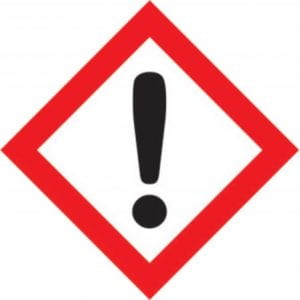
IRRITANT: The cyanotype mixture can also be an irritant to skin and eyes so ensure you always wear gloves and goggles when handling it!
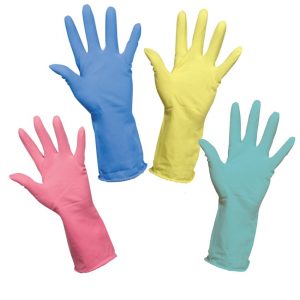
Coating the Paper:

Warning: Cyanotype solution WILL stain clothes and surfaces bright blue! Take care, cover surfaces, wear old clothes and always use gloves.
Photograms with Cyanotype

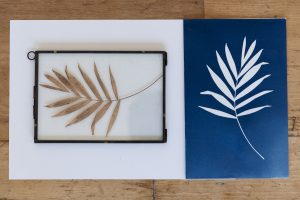
Contact Printing with Cyanotype


Contact printing using an enlarged digital negative

You can also create enlarged negatives from digital image files by printing onto acetate or transparency film. You can then use this to create a positive Cyanotype print the same size as the digital negative.
To do this:
EXPOSURE:
Expose in sunlight or under a UV lamp.
Sunlight: 15 minutes to 8 hours depending on the strength of the sunlight and time of year.
UV Lamp is quicker (approx. 1-15mins) and gives more consistent results.
The coated Cyanotype paper starts off as a yellowish colour and will turn a steely grey colour as it exposes.
Cyanotypes will oxidise and darken to become a brighter blue as they dry.
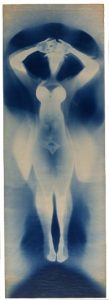
DEVELOP AND FIX:
Develop and fix by immersing in cold running water for approximately 3-5 minutes.
Wash until the yellowish colour disappears from the white areas of your Cyanotype and the water starts to run clear off the print.
Warning: Over washing can erode the image.
Using a citric acid bath in the wash stage can help to gain deeper blues and whiter whites. Place your exposed cyanotype print in a weak citric acidic bath for a minute or two before washing can prevent fading caused by alkaline (hard) water. This should result in a better tonal range within your final print.
Dilutions of lemon juice can be used as a homemade (eco friendly) alternative for a citric acid bath.


USING MATERIALS IN THE HOME
Picture frames or the glass from an old frame can be used in replacement of a contact printer to hold your negatives or photogram materials in place for sharper focus.
Stencils or cut outs are great for bold graphic images.
Pressed flowers, petals, leaves, feathers and other natural materials can be lovely for Photograms.
Textured household materials like bubble wrap or lace can create interesting patterns and can be combined with negatives to create multi layered images or montages.
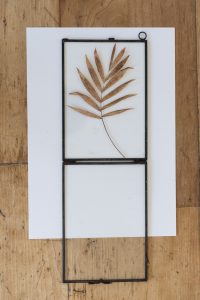
USING THE UV LAMP
ALWAYS WEAR THE UV GOGGLES PROVIDED AS THE UV LAMP IS VERY BRIGHT AND CAN DAMAGE YOUR EYES EVEN WITH BRIEF PERIODS OF EXPOSURE.
THE UV LAMP CAN CAUSE SUNBURN TO SKIN WITH PROLONGED EXPOSURE – KEEP SKIN COVERED AND WEAR WHITE GLOVES (PROVIDED IN THE DEPARTMENT) TO PROTECT YOUR SKIN.
ALWAYS LEAVE THE ROOM WHILE YOUR IMAGE IS EXPOSING AND TAKE REGULAR BREAKS.


USING THE SINK IN THE PHOTO UNIT
Keep your coated Cyanotypes light tight until you are ready to expose.
When ready place them coated side up under the UV lamp with your neg or photogram objects on top – leave to expose.
After exposure you can use the sink in the Photo Unit to wash your cyanotypes and leave them to dry on the drying rack overnight or for at least 8 hours

Sink area for washing your Cyanotype prints – Book in advance via SISO: https://ubhpsu.siso.co/

Artists working with Cyanotype
ROSIE EMERSON

Rosie Emerson is an award-winning contemporary artist working almost exclusively on representing the female form. Her Cyanotype works enable her to montage objects with real size photographic negatives. Using UV light from the sun to expose objects and images directly on to the sensitized surface, the works are often hand painted or gilded with gold leaf.
ANNA ATKINS
Anna Atkins (1799-1871) was a botanist and early photographic practitioner. In October 1843 she became the first person to produce and photographically illustrate a book using cyanotypes. The book was called “British Algae: Cyanotype Impressions” and some of her work is now held in the V&A Museum Collections: http://collections.vam.ac.uk/item/O91281/papaver-orientale-photograph-atkins-anna/


RESOURCES AND LINKS:
- https://blogs.brighton.ac.uk/photounit/cyanotypes-at-home/
-
- https://collections.vam.ac.uk/search/?page=1&page_size=15&q=Atkins%2C+Anna
-
- https://www.jacquardproducts.com/cyanotype-set
-
- https://cyanotype.co.uk/
-
- https://rosieemerson.co.uk/
-
- https://www.rauschenbergfoundation.org/art/galleries/series/blueprints-1949%E2%80%9351
-
- https://blogs.brighton.ac.uk/centrefordesignhistory/2020/04/27/cyanotyping-the-family-snaps/
